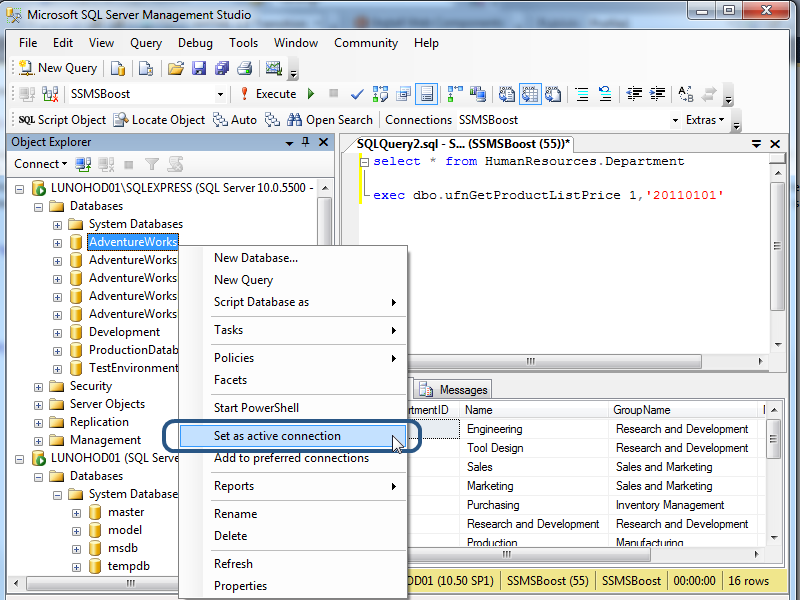Download 2012 Ssms
Fortunately, with SQL 2012 Express, you have a wide variety of download options, ranging from a standalone version of SSMS Express, to SQL.
-->SQL Server Management Studio (SSMS) is an integrated environment for managing any SQL infrastructure, from SQL Server to Azure SQL Database. SSMS provides tools to configure, monitor, and administer instances of SQL Server and databases. Use SSMS to deploy, monitor, and upgrade the in the messages to track when a given query completed its execution.Query Execution or ResultsAllow more data to be displayed (Result to Text) and stored in cells (Result to Grid). SSMS now allows up to 2M characters for both (up from 256 and 64 K, respectively). This also addressed the issue of users not able to grab more than 43680 chars from the cells of the grid.ShowPlanAdded a new attribute in QueryPlan when inline scalar UDF feature is enabled (ContainsInlineScalarTsqlUdfs).SMOAdded support for 'Feature Restrictions*. For information on the feature itself, see feature restrictions. For information on assessment extensions, see Introducing SQL Assessment API.Integration Services (SSIS)Perf optimization for SSIS package scheduler in Azure
For details about what's new in this release, see the SSMS release notes.
Supported SQL offerings (SSMS 18.2)
- This version of SSMS works with all supported versions of SQL Server 2008 - SQL Server 2019 preview and provides the greatest level of support for working with the latest cloud features in Azure SQL Database and Azure SQL Data Warehouse.
- Additionally, SSMS 18.x can be installed side by side with SSMS 17.x, SSMS 16.x, or SQL Server 2014 SSMS and earlier.
- SQL Server Integration Services (SSIS) - SSMS version 17.x or later doesn't support connecting to the legacy SQL Server Integration Services service. To connect to an earlier version of the legacy Integration Services, use the version of SSMS aligned with the version of SQL Server. For example, use SSMS 16.x to connect to the legacy SQL Server 2016 Integration Services service. SSMS 17.x and SSMS 16.x can be installed side by side on the same computer. Since the release of SQL Server 2012, the SSIS Catalog database, SSISDB, is the recommended way to store, manage, run, and monitor Integration Services packages. For details, see SSIS Catalog.
Supported operating systems (SSMS 18.2)
This release of SSMS supports the following 64-bit platforms when used with the latest available service pack:
- Windows 10 (64-bit) *
- Windows 8.1 (64-bit)
- Windows Server 2019 (64-bit)
- Windows Server 2016 (64-bit) *
- Windows Server 2012 R2 (64-bit)
- Windows Server 2012 (64-bit)
- Windows Server 2008 R2 (64-bit)
* Requires version 1607 (10.0.14393) or later
Note
SSMS runs on Windows only. If you need a tool that runs on platforms other than Windows, take a look at Azure Data Studio. Azure Data Studio is a new cross-platform tool that runs on macOS, Linux, as well as Windows. For details, see Azure Data Studio.
Release notes (SSMS 18.2)
There are a few known issues with this release.
For details about this release, see the SSMS release notes.
Previous SSMS releases
Get help for SQL tools
See also


Contribute SQL documentation
Did you know that you could edit the content yourself? If you do so, not only will our documentation improve, but you'll also be credited as a contributor to the page.
Earlier version of Microsoft SQL Server Management Studio showing a query, the results of the query, and the Object Explorer pane while connected to a SQL Server database engine instance. | |
| Developer(s) | Microsoft |
|---|---|
| Initial release | 2005 |
| Stable release | |
| Operating system | Microsoft Windows |
| Available in | English only |
| Website | docs.microsoft.com/en-us/sql/ssms/download-sql-server-management-studio-ssms |
SQL Server Management Studio (SSMS) is a software application first launched with MicrosoftSQL Server 2005 that is used for configuring, managing, and administering all components within Microsoft SQL Server. It's the successor to the Enterprise Manager in SQL 2000 or before. The tool includes both script editors and graphical tools which work with objects and features of the server.[2]
A central feature of SSMS is the Object Explorer, which allows the user to browse, select, and act upon any of the objects within the server.[3] It also shipped a separate Express edition that could be freely downloaded, however recent versions of SSMS are fully capable of connecting to and manage any SQL Server Express instance. Microsoft also incorporated backwards compatibility for older versions of SQL Server thus allowing a newer version of SSMS to connect to older versions of SQL Server instances. It also comes with Microsoft SQL Server Express 2012, or users can download it separately.
Starting from version 11, the application was based on the Visual Studio 2010 shell, using WPF for the user interface. Versions 18 and after are based on the Visual Studio 2017Isolated Shell.[4]
In June 2015, Microsoft announced their intention to release future versions of SSMS independently of SQL Server database engine releases.[5]
See also[edit]
References[edit]
- ^'Download SQL Server Management Studio (SSMS)'. 12 June 2019. Archived from the original on 19 June 2019.
- ^MSDN: Introducing SQL Server Management Studio
- ^MSDN: Using Object Explorer
- ^'SSMS 18.0 (preview 4)'. SQL Server Management Studio - Changelog (SSMS). Microsoft. 24 September 2018. Retrieved 22 October 2018.
- ^'Announcing SQL Server Management Studio – June 2015 Release'. SQL Release Services Blog. Microsoft. 24 June 2015. Retrieved 7 September 2015.
External links[edit]
- SQL Server Management Studio on MSDN